|
|
Studying what they preached
unfortunately takes a long time. You must read much truly disgusting
literature. What they wrote was not what one would expect of clergymen.
Yet one reason they were so successful is exactly that people expected
that clergymen would not lie.
Prof. Justin
McCarthy, 2001
Presentation
|
Prof. McCarthy stated the above as regards to the
missionaries, who frequently forgot the basic commandment THOU SHALT NOT
SPREAD FALSE WITNESS AGAINST THY NEIGHBOR; the Protestant and some Catholic
missionaries felt it was their godly duty to vilify the Turks. However, the
above statement applies no less to many of the Armenian Patriarchs.
Many Armenian Patriarchs chose the road of the end
justifying the means. If that meant professing loyalty to the nation which
allowed their people to prosper for so many centuries, only to go behind the
Sultan's back to spread deceitful propaganda, many of the latter-day
patriarchs did not hesitate. Much of the massacre stories originated from
these religious men, often taken at face value... because clergymen were not
expected to lie.
One example that pops into my head is Arnold Toynbee's
professing, in his 1916 Wellington House report of "The Treatment of
Armenians in the Ottoman Empire," that the Patriarch's 2.1 million figure
of pre-war Armenians would be more reliable than the Ottoman census of 1.1
million. Other than the fact that Toynbee missed the more recent census
proclaiming 1.3 million, and besides another fact that Toynbee himself had
estimated less than one million the previous year (before he became a
propagandist), probably Toynbee had no way of knowing the way the deceitful
patriarchs counted heads was including up to sixty Armenians per household.
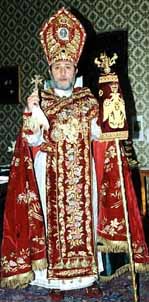 |
|
Karekin II
|
Then there is a
current patriarch, His Holiness Karekin II, Supreme Patriarch and Catholicos
of All Armenians, who conducted a ceremony in May 29, 2000, making the
cowardly mass murderer Dro out
to be a saint. How "Christian" is that?
I wonder if an Armenian Patriarch has ever condemned one
of their many Armenian "heroes" for the crime of ruthlessly
murdering defenseless innocents en masse, not to mention the ASALA and other terrorists who operated in more
recent years.
On this page, we'll look at the shenanigans of these
deceptive and deceitful Armenian priests who supported Armenian death squads,
beginning in the mid-1800s.
Let us begin with what's directly below, a nicely
researched article shedding light on patriarchal history that I discovered in
a newsgroup; the source/author was not credited. (A clue is provided in
"Footnote 63" that the author of "A Mob of Trine"
might be Kamuran Gurun, of "The Armenian File" fame. A
confirmation would be appreciated.)
|
|
|
A
Mob of Trine:
Migirditch Khrimian, Nerses Varjabedian, and Matheos Izmirlian |
-The champion of the opinion for the foundation within the Ottoman
Empire of an autonomous Armenia is the Patriarch Migirditch Khrimian (1869-1873). Born in
Van in the year 1820, Migirditch Khrimian became Vartabed (30) to Akdamar Church when he
was 34 of age and thus became a Church member. In the printing house he caused to be
established at Varak Monastery of Van in the year 1858, he started to publish the
"Eagle of Van", which aimed at Armenian autonomy, and at the St. Garabed
Monastery of Mus, the "Eagle of Mud" newspapers. Khrimian, who drew attention
with sermons he made, was elected Armenian Patriarch of Istanbul in the year 1869(31). Its
election to the position of patriarch would enable Armenian national interests to attain
peaks.
|
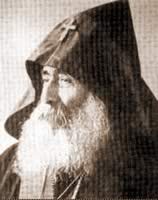
|
|
Patriarch Khrimian
|
-On his coming to
office , the Patriarch Khrimian directed efforts to two basic issues:
-a. to re-examine the Armenian Nation Regulation and to bring
thereon amendments to comply with desires and requirements expressed by the provinces,
-b. to ensure that the government are turned on to Armenia (32).
-In an address made at the Armenian National Assembly, Khrimian had said: " I am a
representative of the Armenia who has suffered. I am fully aware how my predecessors
addressed the government in search of a remedy. But, I will use a much more efficient , a
much more painful way to interfere. (33)
-The bankers , brokers, money-changers and civil servants who
disliked the policy of drawing the Armenians into adventure pursued by Khrimian and
considered their future linked to the existence of Turkey, had taken side against himself.
At the end, Khrimian, who failed to attain the goal he had pursued as patriarch, submitted
his resignation in August, 1873.
-It became quickly noticed that the Patriarch Nerses Varjabedian
(1874-1884) whom replaced Khrimian would pursue his tracks. In the year First Constitution
was proclaimed. The Patriarch Nerses Varjabedian submitted a report to the Istanbul
Conference (12 December 1876-20 January 1877), which was convened in Istanbul to bring a
solution to Bulgarian question, depicting so-called acts of coercion to which the Armenian
subjects of the Ottoman Empire were submitted, which report was entirely prepared by the
former patriarch. However, nothing emerged from the report as the agenda of the conference
dealt with other matters(34).
-The submission of reports of complaint and of petitions started at
the times when Khrimian was patriarch would take a much more terrible shape after coming
to the agenda of the Christians of Rumeli. When reports of oppression and of complaints
submitted to the Sublime Porte (Babiali) and to European government are examined, it is
easily seen that the most of the incidents which such reports depict are nothing but local
police events. While, the Partiarchate, on the one hand, was making heard even the most
ordinary events to the government, on the other, with quite lot of exaggeration provided
reports to the representatives of the European governments in a bid to show them as if
these were political events of utmost significance.
-Two ways appeared to be existing for the Armenians before the war
of Ottoman-Russian of 18771878 was waged:
-a. to remain loyal to Ottoman Government and to Turks,
-b. to give course to actions by keeping track of activities pursued
by other Christian communities present in the Empire and to await opportunities for the
European governments intervention.
-The war, which the Tsarist Russia started against the Ottomans in
the Balkans and Caucasia against the Ottomans with the object of framing the Pan-Slavist
movement in the Balkans on 24 April 1877 unfolded promptly ended up with the coming close
to San Stefano (Yesilkoy) of the Tsarist armies(35).
-When, in the First Constitutional Assembly, the official bulletin
as regards Russia waging war against the country was being announced on 25 April 1877, a
wave of tremendous emotion emerged and in an address made, Marion Effendi, the Armenian
deputy of Halep (Aleppo) was quoted as saying " I declare in connection with our
being both Armenian and Christian that we do not need the protection which Russia
suggests. We can in no way accept the patronage which Russia puts before us and we do not
need such a hand.
-We have never parted company with our Muslim friends nor will we
do.
|
If tiny Armenia
was truly the first Christian state on earth why in the world doesn't your state owned church teach love and forgiveness? Even in Christ's time there was the separation
of church and state. Armenia must separate its church and state if the true message of
Christ is to be taught there. This is why your church has engaged in terrorism from
the mid-1800s up to and including this very day. The Armenian Church is nothing more
than a front and an extension of your state run terror machine.
Christian Scholar Samuel Weems,
in a 2002 reply to hate mail
|
-The Patriarch Nerses, in turn in a correspondence
dated 13 April 1878 forwarded to the Foreign Secretary of Great Britain, Lord
Salisbury, was giving utterance to the following : "It is no more possible for
the Armenians to live together with the Turks. Only a Christian administration is
able to secure equality, justice and freedom of conscience. Muslim administration
should be replaced by a Christian one. Armenia (Eastern Anatolia) and Cilicia(37)
are among places where it entails setting up Christian administrations ...The
Armenians of Turkey, thus want this. That is to say, in the Armenia of Turkey they
desire having a Christian administration in trust as the case is in Lebanon.”(38)
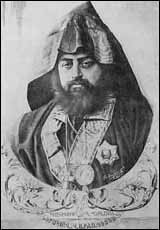 |
|
Nerses Varjabedyan |
-The Patriarch Nerses making a visit to the
Ambassador of Great Britain in Istanbul on 17 March 1878 was reported as saying
"...a year before, we had no complaint to raise against the Ottoman
Administration; but, now the victory by the Russians caused change in the situation.
We claim having an autonomous Armenia in the Eastern Anatolia. If you feel unable to
give us a hand, to go what through this we will address Russia." On the
Ambassador asking what he meant by Armenia, the reply was quoted as "Van, Sivas,
Diyarbakir and Cilicia."
As the Ambassador replied "but in none of
such places you have the majority" the Patriarch said: "we do know this;
but now Russia gained area in the East; the balance of power between Russia and
Ottoman Empire changed. We have to consider our future.”(39)
-However, in the early days of the war, the
same Patriarch Nerses had made it public that his person is an Ottoman patriot loyal
to Ottoman Sultan (40). As the war approached its close, The Armenian Assembly
meeting under the presidency of Varjabedian resolved to make an address to Russian
Tsar. In a memorandum forwarded to the latter (41) they claimed that the areas in
the Eastern Anatolia down to Firat (Euphrates) river should not be returned to the
Turks, that these be annexed to Russia and if otherwise, the alike privileges to be
conceded to Bulgaria and to Bulgarian nation (community) be also yielded to the
Armenian nation, that in case a need arises to evacuate the areas occupied, a
guarantee in kind should be sought and that the Russian occupation be continued till
reformation is put into operation and completed.
-The Ottoman-Russian war of 1877-1878
terminated with the entering into effect of the armistice on 31 January 1878 at
Edirne initiated on demand of peace b) Ottoman following the capitulation of Plevne
and the opening of the way to Istanbul to Russian forces(42). The conditions for
peace were negotiated at San Stefano (Yesilköy). On initiation of the armistice
negotiations at Edirne, the Patriarch Nerses Varjabedian detailed the archbishop of
Edirne, Kevork Vartabed Ruschuklian and Stephan Aslanian Pasha and Hovannes Nurian
Effendi, members of
the Turkish delegation, to see to the Armenian interests(43). The former Ambassador
o: Russia to Istanbul, Ignatiev, who was member of the Russian delegation announced
the Armenian delegation that the privileges to be yielded to the Bulgarian would not
be conceded to themselves, but they had to brace themselves for the day on which the
autonomy would be ceded to them(44). In spite of all bids made, the Armenian
delegation could obtain nothing of avail from Edirne Armistice talks.
-At the end, in the course of peace
negotiations which continued at San Stefano (Yesilkoy), the Patriarch Nerses
Varjabedian and some notables of the Armenian community came in person to have a
talk with the Grand Duke Nicholas, the brother of the Tsar and succeeded to have a
clause entered into the treaty in connection with the Armenians.
-The expression "Armenia" mentioned
in the article XVIth of the San Stefano Treaty entered by and between the Ottoman
Empire and the Russia on 3 March 1878, which contained extremely harsh conditions
against the former, had caused the Ottoman Empire to acquiesce to the existence of
such a country. However, the subject treaty would not be put into effect. Because,
Russia had affected the international balance present in the Middle East and this
had caused the Great Britain to express dislike as this latter pursued a policy of
protecting the integrity of the Ottoman Empire.
-On becoming aware of the news that the Treaty
of San Stefano will be subjected to modifications, the Patriarch Varjabedian moved
and initiated activities with the governments invited to convene in Berlin. In line
with this object, the archbishop of Besiktas, Khoren Nar Bey, went to Russia (St.
Petersburg) and was received by the Tsar Alexander II. Khoren Nar Bey requested from
the Tsar that the patronage the Russians provided to the Armenians be continued,
that the defense of their causes be taken on at Berlin Congress. Another delegation
under the presidency of the former Patriarch Khrimian had started a series of visits
to European capitals (Rome, Vienna, Paris, London) to win the politicians of these
countries to their sides in defense of the Armenian Cause (Hal Tahd). The delegation
was fitted out with a project consisting of seven articles prepared to make specific
the Armenian claims and to pave the way for the founding of an Armenia in
Turkey(45).
-On the other hand, the Patriarch Nerses
Varjabedian, in a correspondence (46) forwarded to Karekin Papazian, the Head of the
Armenian Committee in Manchester, mentioned that their goal was to attain material
and spiritual welfare through expressing gratitude towards Russia and expecting hope
from the Great Britain. The Patriarch in the meantime had again visited the
Ambassador of the Great Britain, Mr. Layard, to express the view that their parties
had prepared a project for submission to the assembly, that it would be appreciated
if the Great Britain backed the same(47).
-Moreover, the Patriarch Nerses, had forwarded
statistics drawn up by clergymen attaining large figures, deliberately tempered
with, as regards the Armenians living in the Ottoman Empire, to Great Powers.
-At the end, the sham question was accepted as
the article 61 of the Berlin Treaty signed on 13 July 1878, without being much
modified the Article 16th of the San Stefano Treaty. In this way, the "Armenian
Question" was being identified as a a problem of reformation to be carried
through under the supervision of the Great Powers in the Ottoman Empire. The Article
61th did not provide the Armenians with independence or autonomy alike Lebanon,
brought them nothing but a promise to bring reformation. The Armenians were not
delighted with the emergence of such a situation. Therefore, after a few while, they
would make bids to initiate riots and to shed blood under the guidance of their
Church and would demand Russia and Europe to interfere with.
-In a pamphlet issued in the year 1879 by
Nuriaz Cheraz who had acted as translator-clerk in the delegation of the former
Patriarch Khrimian to Berlin Congress, the author laid emphasis upon having no
grounds for the Armenians to fall in distress with the results obtained and
addressed the same as follows(48): "The Berlin Congress enabled us to lay the
foundations of the national building which we plan to erect in years ahead.. Europe
gave into our hands arms; we have to use such arms before the same becomes rusty...
we have through the Berlin Congress come by a gold mine; it falls upon us to run
such a mine and to dig gold out." As would be appreciated, the pamphlet
suggested the Armenians to have recourse to armed action, that they had behind
themselves European states to back them.
-The Patriarch Nerses Varjabedian nourished the belief that the question could only
be solved through revolution and rioting and had set up a commission hidden under
the title of "Reformation Commission" operating at the patriarchate for
the achievement of it. A circular sent to the bishoprics in the midst of the year
1879 by the above-cited commission was openly inviting the Armenians to take arms.
The subject circular was asking the Armenian clergymen in the provinces to abide by
the following(49)
-1. In order to keep alive the question of
Armenia, the Armenians of Gregorian, Protestant, Catholic sects and of other sects
should be kept as an unified whole on this issue,
-2. The opinions of the children taking
instruction at schools should be infused with the Armenian question. At villages
having neither school nor means to hire instructors, the priests should teach the
boys and the girls at least how to sign their names. They should further teach the
illiterate elders at towns and villages how to write down. At least, these should be
able to set their hands. Because, on days ahead, this would be necessary,
-3. Armenian Synods at the provincial centres
and their spokespersons should frequently meet with the foreign consulates. The
grievances suffered by the Armenians should openly be made known to consulates and
with consular staff, a close relation should be established,
-4. Europe shall see to the rights of all
Armenians and shall back them. All civilized governments of Europe are ready to do
so. To hear grievances suffered by the Christian Armenians and to bring solution to
them is required in compliance with the provisions of the article 61 of the Berlin
Congress. Nothing sooner than the present moment, we have to make our best to prove
the consulates how the Armenian people are skillful, honest and eager to absorb
knowledge, to make the same agree with how much desire we feel for reformation and
security,
-5. Notwithstanding where we are and what we
do, the European travellers with whom we run across should be greeted with cheerful
face, the Armenians hospitality should be displayed. The old Armenian stories should
be told to them for they become a backer of the Armenian Cause (Hai Tahd),
-6. Such matters should be made known to
synods, priests and Church communities and efforts to insinuate the same should be
made,
-7. The Ottoman Empire would not be in a
position to hinder sincere relations which you would establish with the European
travellers. If oppression and torture is inflicted owing to such relations, the
local government authorities and the consulate the nearest to sites should be made
familiar with the situation, and all happenings with all details required should be
written to the Patriarchate.
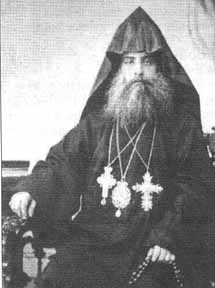 |
|
Matheos Izmirlian |
-In the meantime, the primate Matheos Izmirlian,
who was the acting Patriarch in Istanbul, was not dallying away and battered the
bishoprics with correspondences. If these latter are carefully investigated, it
exhibits itself that the Patriarchate was openly in betrayal, that the conduct it
had chosen for itself to pursue was subversive, conducive to bringing intervention
by foreign powers and contingent on seeking autonomy at the end(50).
-The province of Sivas was one of the Six
Provinces (Alti Vilayet=Vilayat-i Sitte) on which the Armenians were laying claim.
In other words, these were lands located West of Armenia which was planned to set
up. Therefore, in terms of the allegations by the Armenians made. It was of a
distinct significance. The coded correspondences pertinent to the years 1881 and
1882 which conveyed to the Home Office activities against the government conducted
by the Patriarchate, forwarded by the governor of Sivas, Hakki Pasha, were drawing
attention to the following matters(51)
-1. The Patriarchate had started to forward
circulars to bishoprics indicating that preparations for initiating a revolt and
inciting uprisings were under way,
-2. The Patriarchate had dismissed some bishops
and priests in their right minds, whom had grasped the fact that revolts and
uprisings would bring no outlet to Armenians, that interests of the Armenian
community would be much harmed by, whom had rejected abiding by the instructions
issued by the Patriarchate (which had some of these priests killed) and had
nominated in their steads younger, much more aggressive ones,
-3. The Patriarchate, with circulars sent
underhanded, had attempted taking population censuses, which was a commission to be
performed by government authorities, with a view to indicating to European Powers
that their parties held majority in the Six Provinces,
-4. The Patriarchate had collected duties from
the Armenians under various names (under the colour such as aid to the Armenians who
suffered from dearth, reimbursement of the debts payable for the Holy Jerusalem) and
initiated large scale campaigns in Europe through press media in favor of the
Armenians and against the Turks. As a consequence of such campaign, even the most
ordinary events of murder were being displayed in the press as the killing in mass
of the Armenians. Reports of murders published by the press had most of the times
no connection whatsoever with the Armenian Question. In brief, the events were being
turned upside down to continue a campaign which was contingent on calumniation,
slander and fabrication,
-5. The Patriarchate had on hand hundred of
thousands liras (gold) amassed under the colour of "aid" from the
Armenians. With a portion of the monies thus collected, the armed mobs acting in
collaboration with the local volunteers initiated acts of terrorism after their
being introduced to the country from the Russian borders into the Eastern Anatolia,
-6. The priests, in the course of the last
three to four years had washed brains of the entire Armenian communities to go down
to little children taking instruction at schools and thus had uprooted respect and
obedience against instructions issued by the governmental authorities,
-7. The Patriarchate, further to its acting as
leader in the establishment of the committees, had made huge sums allocated to such
committees. There is benefit in mentioning that these committees were under order
and sway of the Patriarchate.
-Following the death of Nerses Varjabedian in the year 1884, as Patriarch in his
stead, was nominated the bishop of Erzurum Harouthioun Vehabedian (18851888) in the
year 1885. This latter did not approve policy pursued by Migirditch Khrimian and
Nerses Varjabedian and was convinced that awaiting any hope for help from Europe for
the improvement of the Armenians situation in Turkey was of no avail. In the
meantime, the former Patriarch Khrimian and his followers continued their programmes
of defeatism. On the other hand, the Armenian bishops in accordance with
instructions provided to themselves were active in the provinces of the Eastern
Anatolia and were not shrinking from doing whatsoever is necessary to ascertain
European powers' intervention. The Patriarch Harouthioun Vehabedian was familiar
with preparations made underhand both at overseas and in provinces. In the
meanwhile, the Patriarchate of Armenian Church in Jerusalem, with the decease of the
Patriarch Yesayi Karabedian (1864-1885), had become vacant. By taking advantage of
the vacancy and acting with the hunch of grievances and difficulties to arise in
years ahead, the Patriarch decided to quit the Patriarchate of Istanbul to become
the Patriarch of Jerusalem. At long last, with the ratification reluctantly conceded
by the Sublime Porte, he was nominated Patriarch of Jerusalem(52).
|
| Admit
or deny that it was a high priest of the Armenian Church who first made-up and told
the great lie that the Ottomans were massacring Armenians in Anatolia. Proof of this
fact, which is in my book, is that your high priest concocted and started telling this
tall tale 3 days after the Ottoman government announced it was removing disloyal
Armenians who were helping the invading Russians. Your Armenian forefathers pretended
to be loyal Ottoman friends and neighbors by day but in truth were disloyal cowardly
traitors by night. I notice that you Armenians never once admit that you were helping
the Russians in your greedy, get something for nothing, land grab attempt and this is
why the Ottomans threw your forefathers out of the country.
Your high priest started telling his
made up tall tale almost a full six weeks before a single Armenian behind the Ottoman
army packed a bag to leave. Clearly there could not have been a massacre as your state
owned church claims. I have the documented proof of this fact from the archives in
Moscow, London, Paris, and Washington, D. C. What do you say about that?
Samuel Weems, in a 2002 reply to hate mail
|
In the course of office term of Harouthioun Vehabedian, which
was three years, the Armenian riot committees expanded their structures and opened
branch-offices in Europe and America. Therefore, the Armenian nationalism, in other words,
the revolutionary movement aspiring autonomy was changing hands from the Church to
Armenian Revolutionary Parties. The first Armenian political party "Armenagan"
with a certain efficacy, organized in line with the identical ones in Europe, having its
own publishing organ, was set up at Van in the year
1885(53). The Armenians founded their first Marxist party in Geneva in the year 1887.
These later in the year 1890 will became "Hunchak Revolutionary Party"(54).
In place of Harouthioun Vehabedian was nominated Khoren Ashikian (1888-1894), the Chief
Priest of Izmit Monastery, known as an impartial priest. In the course of his office term,
events of ordinary extent to occur in provinces were being exaggerated by the bishops and
were reflected onto European scene as "Turkish oppression and torture" always
with the claim that Europe should interfere in. On the other hand, with to object of
bringing together the Armenians which had become dispersed as a result of coercive means
used by the Tsar in Russia to remove radicalism, an Armenian Revolutionary Federation (Dashnak)
was set up at Tiflis in the year 189055. Now on, the riots had become entirely
consecutive, any coincidence being beyond question. At the date of 28 June 1890, a bloody
riot occurred at Erzurum. This was followed by demonstrations at Kumkapi on 15 July 1890,
and riots at Merzifon, Kayseri and Yozgat. With the conviction that he did not act as
required, the committeemen arranged a criminal attempt against the Patriarch Khoren
Ashikian, in which he was simply wounded. Following the event, he asked demission(56)
To replace Khoren Ashikian, the former Armenian Patriarch of Egypt, Matheos Izmirlian
(1894-1896) was elected as Armenian Patriarch of Istanbul. With the election to the post
of Patriarch of lzmirlian, the Hunchaks were delighted. The new Patriarch provided
employment to committeemen and detailed them for services. He was not contending himself
with spreading only his views on revolution and rioting, further to these, criticized with
hard words all actions taken by the government and was sending reports both to British
Embassy and to newspapers in London(57).
The insurrections carried out for the sake of Armenian autonomy in the course of Matheos
izmirlian's office term spread with a speed almost in all provinces(58). These
insurrections were suppressed within a short time through the tact displayed by the Sultan
Abdulhamid II. The Armenians frustrated with emptiness of hopes inspired by the British
policy had grown weary of Matheos Izmirlian. Moreover, the Armenian notables, who were in
disagreement with the irreconcilable manner taken by himself since the day of his election
and the upper level civil servants in the service of the Sublime Porte were suggesting him
to resign. Philip Currie, the British Ambassador with drew his support from him. Even, the
Senate member, the Armenian, Abraham Kara Kehya Pasha, had told him he would no longer be
of service towards his community and he would do good if he did not continue sitting in
his office. All of these negative happenings caused Matheos Izmirlian to demission(59).
Following submission of his demission, he went to Jerusalem in September of the year
1896(60). He would only be able to return to Istanbul following promulgation of the Second
Constitution to become the Patriarch elect for the second time (1908-1909)(61).
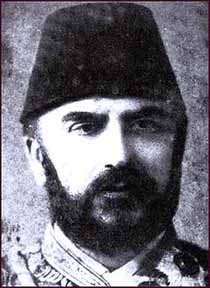 |
|
Artin Dadyan Pasha |
Following resignation of the Patriarch Matheos lzmirlian, the Bishop
of Bursa, Mgr. Bartolomeos was nominated as acting patriarch. The Sublime Porte
provisionally detailed a Mixed Council to be formed of clergymen and of eight secular
members to replace civilian and religious synods existing at the times of office held by
the former Patriarch, lzmirlian(62). A few times later, there occurred in Istanbul the Ottoman Bank raid (63) plotted by the
Dashnak Party in Istanbul on 26 August 1896. The Mixed Council meeting under the
presidency of Artin Dadian Pasha, in the meanwhile, elected as the Armenian
Patriarch of Istanbul, Malachia Ormanian (1896-1908).
|
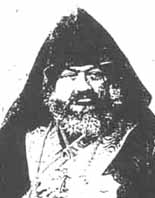
|
|
Malachia
Ormanian
|
-On the occasion of the 25th
anniversary of the access to the throne of the Abdulhamid II, the Patriarch Ormanian ran a
thanks giving ceremonies at Kumkapi Church and prayed God for the good of the Sultan after
an address he made to make explicit grounds for the Armenians to remain faithful to
Ottoman Empire (64). The Ottoman Government, in turn, attempted to inspire more trust for
itself and to gain afresh the loyalty displayed by the Armenians. By the proclamation of
an amnesty by the Sultan, all Armenians exiled or confined were set free.
-In the same period, the Armenian religious people continued their
ruinous activities. Frustration and hopelessness experienced would push the Armenians into
new ventures and the same would follow the tracks of the new illusions. As a matter of
fact, the bishop of Cilicia region, Paul Terzian, would initiate activities for the
founding of a sham Armenian state, comprising the areas of Maras and Adana provinces,
called the Lesser Armenia. With an underhanded correspondence dated July 6, 1898 written
to Foreign Minister of France, he, after raising complaints against the Ottoman
Government, was offering setting up of a lesser Armenian state under the auspices to be
provided by France (65). However, such an offer was brought to the knowledge of Abdulhamid
II, and was definitively rejected.
|
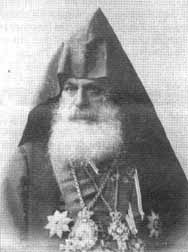
|
|
Kevork V
|
-In the year 1899,
delegations elected from the various parts of the country, under the spokesperson of Minas
Cheraz, applied to the Peace Conference held in the Hague and submitted a memorandum so
that autonomy is conceded to Armenia (66).
-The Armenian committees directed by the Patriarchate, in a congress held in Paris in the
year 1905, had resolved to establish an Armenian state in Cilicia (Adana, Maras and their
environments)(67). Actually, this resolution was again nothing but the alliance of the
cross. and the sword.
The article did not cover the war time Patriarch,
at least not this version I came across; that would be Kevork V (1911-1930). The Armenian
religious leader Hrant Vartabed wrote that "'The establishment of protestant
communities in Ottoman territory and their protection by England and the United States
shows that they did not shrink from exploiting even the most sacred feelings of the West,
religious feelings, in seeking civilization", going on to state that the Catholicos
of Echmiadzin Kevork V was a tool of Czarist Russia and that he betrayed the Armenians of
Anatolia.
ADDENDUM and CORRECTION: The learning curve never ends. The wartime patriarch was not
Kevork V. The Catholicos of Echmiadzin is a different religious entity. This represented
the head of the Armenian Church, first established in 301 A.D., later to move around
beginning in 485, and then to return to Echmiadzin in 1441.
The Armenian Patriarchate, the head of the Armenian millet within the Ottoman Empire,
represented the other branch of Armenian religious (and in the Ottoman Empire, certain
non-religious) leadership.
|
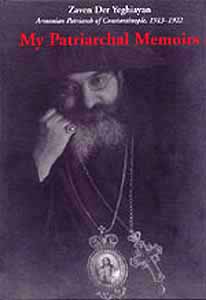
|
|
Zaven on cover
of memoirs
|
The wartime patriarch was "Zaven,"
originally named Mikayel Ter-Yeghiayan before being ordained as a celibate priest by
Ormanian in 1895. Zaven became patriarch in 1913, deemed untrustworthy by the Ottomans and
sent away to Baghdad in 1916, returned to Istanbul in 1918, left before Ataturk took over,
and finally settled in Baghdad (in 1927, for good), until his death in 1947. A book
containing his words is entitled "My Patriarchal Memoirs."
ZAVEN ADDENDUM, 9-2006: “One day Tehlirian
was summoned by Patriarch Zaven. Zaven was exiled in 1915 and the Armenian Church suffered
greatly as a result of Mugerditchian’s
betrayal. The Patriarch received and blessed Tehlirian and stated that Mugerditchian was
three times worse than a traitor and he officially condoned Tehlirian’s act.”
(Edward Alexander; "A Crime of Vengeance — An Armenian Struggle for
Justice," 1991, p. 45. Alexander was a U.S. Foreign Service Officer of
Armenian descent.) Mugerditchian was accused of providing a list of Armenian ringleaders
to Talat Pasha; if he did so, he was concerned about the Armenian rebellion rocking his nation during dangerous wartime, and
was anything but a traitor. Zaven, by blessing a murderer, was a traitor to his religion.
|
Footnotes
|
(30) The clerical grades in the Armenian
Church are as follows: Catholicos, Patriarch, Yepiscopos ( bishop ) , Vartabed,
priest.
(31) Esat Uras, ibid, p. 417; Louise Nalbandian, ibid, p. 53; Kamuran Gürün, ibid,
pp. 62,74-75.
(32) What is meant by the expression Armenia in here, is the Eastern Anatolia.
However. the scientific environments agree on the Armenia being not an ethnical
expression but rather a geographical one. To the geographical name
"Armenia". Which stands for uplands/mountainous lands, mention would no
more be made following the XIIIth century and the region (the Eastern Anatolia)
until the second half of the XIXth century would be named as "Turcoman
Country". For a much itemized information. See H. Kenial Tfrkozf, Türkmen
ülkesi (Dogu
Anadolu) Adi ve Emperyalizmin Etkileri, Ankara 1985, p. 1-12; Kamuran Gürün, ibid,
pp. 1-9: Mehlika Aktok Kasgarli, the above mentioned article, p. 329: Tuncer Baykara,
Anadolu'nun Tarihi Cografyasina Giris, Anadolu'-nun Idari Taksimati, 1, Ankara 1988,
pp. 2425.
(33) Mikael Varandian, Origins of the Armenian Movement, Vol. 11, Géneve 1913, p.
49, mentioned by Esat Uras, ibid, p. 413.
(34) Esat Uras, ibid, p. 417; Salahi Ramsdan Sonyel, The Ottoman Armenians, p. 41--
(35) Falur H. Armaoglu, qualified the Ottoman-Russian war of 1877-1878 as the work
of the Balkan Slaves, whom Bismarck called "burglars of sheep", acting
under the impetus of PanSlavism. See Siyasi Tarih Dersleri (1789-1919), Ankara 1961,
p. 368.
(36) Enver Ziya Karal, Osmanli Tarihi, Vol. VIII, p. 235-236.--
(37) Cilicia is the region which is situated amid Taurus mountains, Amanus mountains
and the Mediterranean Sea. In administrative sense, Cilicia is the name given to
Adana province in the Ottoman Empire. The boundaries of Cilicia have time by time
been subjected to change.--
(38) F.O. 424/70, Nu.134/1, mentioned by Bilal N. Simsir, British Documents on
Ottoman Armenians (1856-1880), Vol. 1, Ankara 1982, p. 173, document No. 69.--
(39) Kamuran Gürün, ibid, p. 99.--
(40) The statement by Nerses Varjabedian made to express loyalty to Ottoman Sultan
had caused him to be named as traitor of the Armenians, as the case was the same for
Patriarch Hovagim. See Arev. 30.5.1985, p. 3. --
(41) Esat Uras, ibid, p. 439; Kâmuran Gürün, ibid, p. 97.--
(42) Nihat Erim, Devletlerarasi Hukuk ve Siyasi Tarih Metinleri Osmanli
Imparatorlugu Andlasmalari, Vol. 1, Ankara 1953, pp 381-385.
(43) Esat Uras, ibid, pp. 451-457. --
(44) Esat Uras, ibid, p. 452.--
(45) For the whole text of the project. see Esat Uras, ibid, pp. 459485: Enver Ziya
Karal, ibid, Vol. V111, p. 132: L'Angleterre et les Armeniens (1839-1904), pp.
19-22.--
(46) For the text of the letter, see Esat Uras, ibid, pp. 485-486.
(47) Kamuran Giirun, ibid, p. 104.
(48) Turkey Nu. 4 (1880), Nu. 118/1, mentioned by Bilal N. Simsir, ibid, pp.
602-606, document Nu. 309.--
(49) Mehmed Hocaoglu, Tarihte Ermeni Mezâlimi ve Ermeniler, Istanbul 1976, pp.
181-182.--
(50)As regards content of the correspondence, see Aspirations et Agissement
Revolutionnaires des Comites Armeniens..., pp. 308-310.--
(51) Mehmed Hocaoglu, ibid, pp. 182-185.
(52) Aspirations et Agissement Revolutionnaires des Comites Armeniens..., p.13;
L'Angleterre et les Armeniens (1839-1904), pp. 28-29; Esat Uras, ibid, p. 514.
(53) Louise Nalbandian, ibid. p. 90.--
(54) Louise Nalbandian, ibid, pp. 104. 117.
(55) Louise Nalbandian. ibid, p. 151.
(56) Esat Uras, ibid. p. 724-725.
Antragsteller regards the letter of threat sent by Hunchak Committee to Horen
Ashikian_ see Aspirations et Agissements Revolutionnaires des Comittes Armeniens...,
pp. 310-311.--
(57) Hüseyin Nazim Pasa. Ermeni Olaylari Tarihi, I. Ankara 1994, p. 66.--
(58) For a chronological listing of the uprisings, see Kamuran Gürün, ibid, pp.
139-159.--
(59) L'Angleterre et les Armeniens (1839-1904), p. 40.
(60) Esat Uras, ibid, p. 774; Salahi Ramsdan Sonyel, The Ottoman Armenians, p.
209.--
(61) Esat Uras, ibid, p. 883: Salalii Ramsdan Sonyel, ibid. p. 281.
62) L'Angleterre et les Armeniens (1839-1904), p. 41.--
(63) Concerning how the event did run, see Kamuran Gürün, A Mob of Trine:
Migirditch Khrimian, Nerses Varjabedian, and Matheos Izmirlian
|
| Patriarchal Population Hocus Pocus |
Let's get an idea of how these patriarchs determined their statistics for the
Armenian numbers.
A letter written by Patriarch Nerses,
on 24 June 1880, to
the British Ambassador:
"...The previous censuses of the population have been done on the basis of
number of houses; this method is absolutely erroneous, as the number of inhabitants
of every household are by no means identical, and depend on whether the houses are
occupied by Christians or Muslims. According to Muslim tradition, different families
can't live in the same house; in Armenia custom, however, children and brothers
after, as well as before their marriage, continue to live together. As a result,
while one must count at most 3 to 8 inhabitants in a Muslim house, we can count 12
to 60 in Armenian house..."
^^^^^^^^^^^^^^^^^^^^^^^^^^^^^^^^^^^^^^^^
SIXTY PEOPLE IN THE SAME HOUSE?
^^^^^^^^^^^^^^^^^^^^^^^^^^^^^^^^^^^^^^^^
(And there's another lie, with the above; the described situation is
totally the reverse, in Turkish tradition; sons would continue
to live in the same house with their parents, after they
became married.)
So that's why the Patriarch's figures are
always so ballooned up!
By the way, here's how the Patriarch finished
his letter: "I realize how much your Excellency is already inclined in
favour of the Armenian cause, which is the one of humanity and justice." (Wink-wink!)
(However, Lieutenant-Colonel C. W. Wilson, in a
memorandum prepared for the Ambassador, didn't fall for the Patriarch's phony facts.
He wrote: "The letter of the Armenian Patriarch shows a great lack of
knowledge concerning the local realities of the population of the province of Sivas
and the Christian population.")
Let's see how the Patriarch's figures compare
with the range of "neutral" sources (Cuinet=C,
Lloyd=L, Lynch=LY)
|
Patriarch |
Ottoman |
Highest |
Lowest |
| Erzurum |
215,177 |
121,935 |
134,967 (C) |
106,768 (LY) |
| Van, Bitlis |
348,500 |
140,854 |
168,938 (C) |
164,620 (L) |
| Diyarbekir |
88,800 |
86,202 |
101,579 (C) |
90,034 (L) |
| Elaziz |
158,000 |
84,422 |
93,000 (LY) |
69,718 (C) |
| Sivas |
243,515 |
131,361 |
170,433 (C) |
170,433 (C) |
|
|
|
|
|
| Total |
1,053,992 |
564,774 |
668,917 |
601,573 |
(K. Gurun, "The Armenian File," pg.
95)
Now we can see who is more "reliable": the Ottomans, or the
Armenian Patriarch.
Why are the highest
figures provided by no one but the Patriarch?
The obvious answer: truth was not the
Patriarch's most pressing concern.
The Armenian population of eastern Anatolia,
"make-up" by the Armenian Patriarchate :
|
(a *) b |
c |
d |
e |
f |
|
(1880) |
(1880) |
(1881) |
(1882) |
(1912) |
| Erzurum |
215,177 |
111,000 |
128,478 |
280,000 |
215,000 |
| Van |
184,000 |
|
133,859 |
400,000 |
185,000 |
| Bitlis |
164,508 |
252, ** |
130,460 |
250,000 |
180,000 |
| Diyarbekir |
|
88,000 |
|
150,000 |
105,000 |
| Elaziz |
|
155,000 |
107,059 |
270,000 |
168,000 |
| Sivas |
|
199,245 |
243,515 |
280,000 |
165,000 |
| Total |
|
|
|
|
|
* In 1878, the combined population of Erzurum + Van+ Bitlis was 1,150,000
** 252,500 = Van+Bitlis
a: to Berlin Congress
b: to Sir Charles Dilke
c: Patriarch's list
d: Patriarch's list
e,f: Marcel Leart (Krikor Zohrap)
"It is apparent that there is no possibility of taking these lists
seriously," wrote Kamuran Gurun in "The Armenian File." Who could
argue?
Gurun also tells us the following, shedding further light on the Patriarchs'
dishonesty:
"The fact that the Patriarchate did not
repeat the 3,000,000 figure it gave to the Berlin Congress, but reduced it to
1,780,000, is significant. It is understood that the Patriarch spoke without
reflection, thinking that autonomy was going to be obtained anyway, but that he did
not repeat this figure, and even gave a figure under 2,000,000, when he saw that
autonomy was not going to materialize, and he thought of the subject of taxes.
Nevertheless, we shall see below that the figures given by the Patriarch for the six
provinces too are quite exaggerated. It is also useful to remember that the
Patriarch, who said he was basing his figures on the records of the Patriarchate,
never revealed these records. Moreover, it is obvious that Catholic and Protestant
Armenians would not be included in the Patriarchate records.
The Patriarchate figures being what they are,
we can leave aside the Armenian sources who follow the Patriarchate, and Walker, who is obviously the
standard-bearer of the Armenians. Besides, the figures given by Vahan Vardapet,
member of the Patriarchate, clearly contradict them."
The figure for the
Armenian population in Turkey, according to Vahan Vardapet was1,263,000. (According to the Djeridei Sharkieh, an Armenian
newspaper published in Istanbul, dated 3/15 December 1886.)
There are many online sources of Gurun's
indispensible work, which I have barely referred to in the preparation of the TAT
site... I can see that was a mistake. The Links page
features an HTML version or two.
Holdwater adds another
example of Patriarchal population puff: It is well known the Patriarch's pre-war
Armenian population figure was 2.1 million, contradicted by some Armenian
historians from the period, such as Kevork Aslan, who had the number at 1.8 million.
Yet German missionary Johannes Lepsius
stated (as an "under oath" defense witness in the 1921 Tehlirian trial) that the number he obtained from the
Patriarchate was 1,850,000. In other words (assuming known-liar Lepsius did
not "exaggerate" this figure himself; Aslan probably got his number from
the Patriarchate, as well), the Patriarch — just as in the Berlin Congress, when
the Patriarch from that period shifted the figure over a million in a blink of an
eye — shifted the pre-war figure by 250,000, just like that! Abracadabra!
|
"In advancing these figures, the
Armenians might be charged with
MANIPULATION BY EXCLUDING THE PREDOMINANTLY MOSLEM SOUTHERN AND WESTERN BORDER
DISTRICTS. EVEN AT THAT TO ESTABLISH ARMENIAN PLURALITY IT WAS NECESSARY TO LIST
INDIVIDUALLY THE SEVERAL MOSLEM PEOPLES, AND ONLY BY INCLUDING SUCH HETERODOX
MOSLEMS AS THE 'KIZILBASH' IN THE CATEGORY OF 'OTHER-RELIGIONS' WAS IT POSSIBLE TO
ESTABLISH A SCANT CHRISTIAN NUMERICAL SUPERIORITY. FINALLY, IT IS LIKELY THAT THE
FIGURES RELATING TO THE ARMENIANS WERE 'EXAGGERATED' WHILE THOSE PERTAINING TO THE
MOSLEMS WERE
'MINIMIZED'."
Prof. Richard Hovannisian, basically admitting the Patriarchs were liars, in
"Armenia on the road to independence", 1967, p. 37
|
At a meeting last autumn of the Armenian
Assemble Nationale, M. Sdepan Papazian, the reputed author of the statistical Tables
presented to the Berlin Conference, made a violent attack on the Patriarch for having
communicated statistical Tables to the Embassies without having previously consulted the
National Assembly, in consequence of which the enormous divergence between the Berlin and
the more recent Patriarchal figures had attracted attention, and called forth remarks
tending to show the untrustworthiness of both sets of figures. The Berlin compilation, by
a glaringly unfair manipulation of official figures, tried to prove that, according to the
said figures, the Armenian population of Erzerum and Van (including Bitlis and Hekkari)
amounted to 1,150,000 souls. I have subsequently shown that, in all probability, the real
number does not exceed 450,000: while the Patriarchal figures supplied to the Embassy in
1880 gave 373,500 Armenians, plus 85,000 Nestorians.
British Major Trotter, in a memorandum to his Ambassador on February
15, 1882, basically saying the Patriarch was a liar.
|
|